Page is loading ...

20
GB
OVEN
FK 1041 L .20 X /HA
FK 1041 L .20 /HA
7OFK 1049LS C X RU/HA
7OFK 1049LS C RU/HA
UT 104C X /HA
UT 104C /HA
FK 1041.20 X/HA
7OFK 1049L X RU/HA
7OFK 1049L RU/HA
Contents
Installation, 21-22
Positioning
Electrical connection
Data plate
Description of the appliance, 23
Overall view
Control panel
Display in programming mode
Display in cooking mode
Start-up and use, 24-26
Switching the oven on for the first time
Setings menu commands
Control panel lock
Setting the clock
Setting the minute minder
Starting the oven
DEMO mode
Restoring the factory settings
Standby
Modes, 27-33
Manual cooking modes
Automatic cooking modes
Programming cooking
Practical cooking advice
Cooking advice table
Precautions and tips, 34
General safety
Disposal
Respecting and conserving the environment
Care and maintenance, 35-36
Switching the appliance off
Cleaning the appliance
Cleaning the oven door
Replacing the light bulb
Assembling the sliding rack kit
Troubleshooting, 37
Assistance, 38
Operating Instructions
Italiano, 1 Français, 39English,20
IT GB FR

GB
21
! Please keep this instruction booklet in a safe place
for future reference. If the appliance is sold, given
away or moved, please make sure the booklet is
also passed on to the new owners so that they may
benefit from the advice contained within it.
! Please read this instruction manual carefully: it
contains important information on installation,
operation and safety.
Positioning
! Do not let children play with the packaging material; it
should be disposed of in accordance with local separated
waste collection standards (see Precautions and tips).
! The appliance must be installed by a qualified
person in compliance with the instructions provided.
Incorrect installation may damage property or cause
harm to people or animals.
Built-in appliances
Use an appropriate cabinet to ensure that the
appliance functions properly.
• The panels adjacent to the oven must be made of
heat-resistant material.
• Cabinets with a veneer exterior must be
assembled with glues which can withstand
temperatures of up to 100°C.
• To install the oven under the counter (see
diagram) or in a kitchen unit, the cabinet must
have the following dimensions:
* Stainless steel models only
! The appliance must not come into contact with
electrical parts once it has been installed.
The indications for consumption given on the data
plate have been calculated for this type of
installation.
Ventilation
To ensure adequate ventilation is provided, the back
panel of the cabinet must be removed. It is
advisable to install the oven so that it rests on two
strips of wood, or on a completely flat surface with
an opening of at least 45 x 560 mm (see diagrams).
Centring and fixing
Secure the appliance to the cabinet:
• Open the oven door.
• Remove the 2 rubber plugs covering the fixing
holes on the perimeter frame.
• Fix the oven to the cabinet using the 2 wood
screws.
• Replace the rubber plugs.
! All parts which ensure the safe operation of the
appliance must not be removable without the aid of
a tool.
560 mm.
45 mm.
Installation
590 mm.
595 mm.
22,5 mm.*
20,5 mm.
550 mm.
570 mm.
20 mm.
575-585 mm.
45 mm.
560 mm.
550 mm.
min.
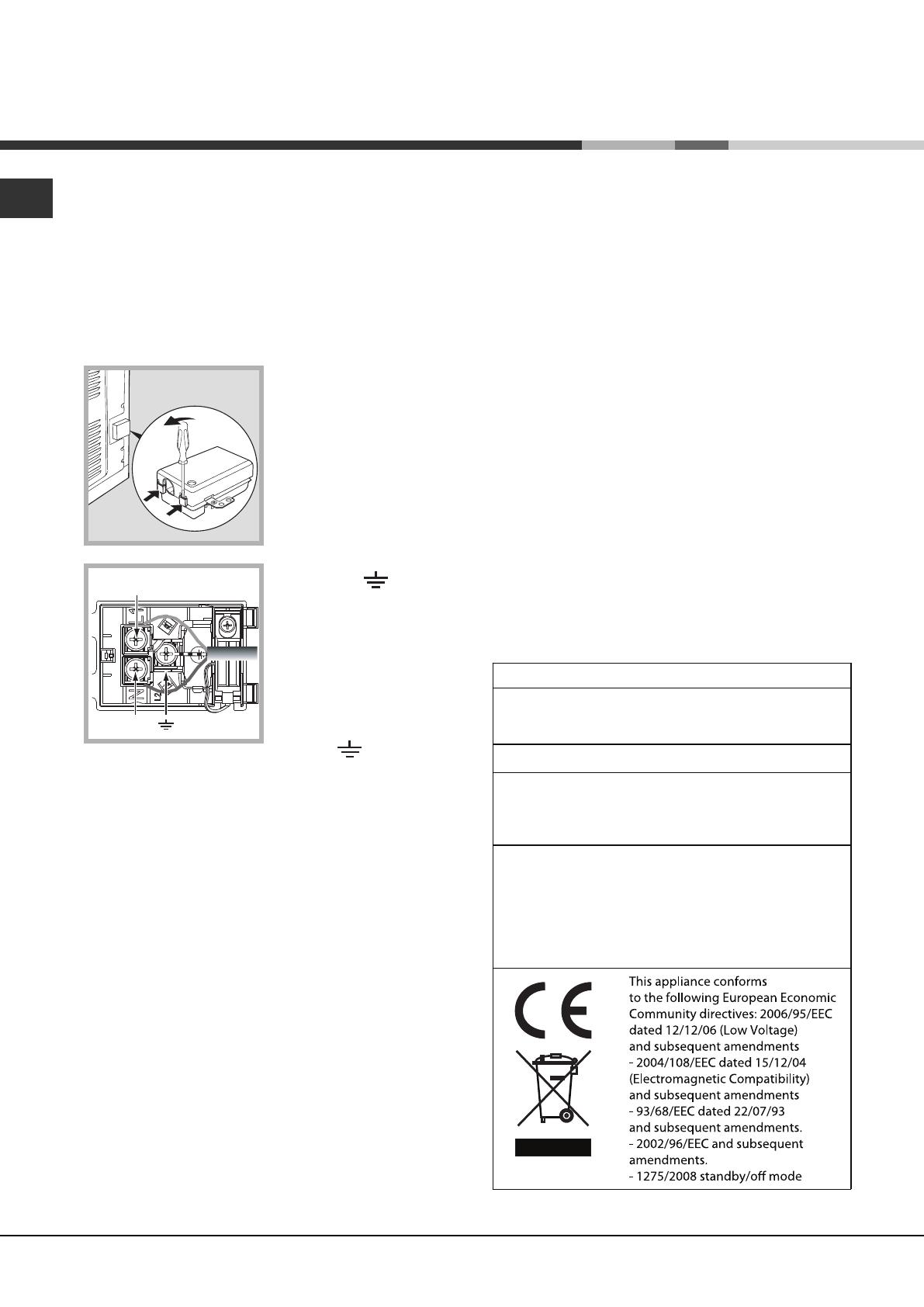
22
GB
Electrical connection
! Ovens equipped with a three-pole power supply
cable are designed to operate with alternating
current at the voltage and frequency indicated on
the data plate located on the appliance (see below).
Fitting the power supply cable
1. Open the terminal board by inserting a
screwdriver into the
side tabs of the cover.
Use the screwdriver as
a lever by pushing it
down to open the cover
(see diagram).
2. Install the power
supply cable by
loosening the cable
clamp screw and the
three wire contact
screws L-N-
.
Connect the wires to the
corresponding
terminals: the Blue wire
to the terminal marked
(N), the Brown wire to
the terminal marked (L)
and the Yellow/Green
wire to the terminal
marked
(see
diagram).
3. Secure the cable by fastening the clamp screw.
4. Close the cover of the terminal board.
Connecting the electricity supply cable to the
mains
Install a standardised plug corresponding to the
load indicated on the data plate (see table).
The appliance must be directly connected to the
mains using an omnipolar switch with a minimum
contact opening of 3 mm installed between the
appliance and the mains. The switch must be
suitable for the charge indicated and must comply
with current electrical regulations (the earthing wire
must not be interrupted by the switch). The supply
cable must be positioned so that it does not come
into contact with temperatures higher than 50°C at
any point (the back panel of the oven, for example).
! The installer must ensure that the correct electrical
connection has been performed and that it is fully
compliant with safety regulations.
Before connecting the appliance to the power
supply, make sure that:
• the appliance is earthed and the plug is compliant
with the law;
• the socket can withstand the maximum power of
the appliance, which is indicated on the data
plate (see below);
• the voltage is in the range between the values
indicated on the data plate (see below);
• the socket is compatible with the plug of the
appliance. If the socket is incompatible with the
plug, ask an authorised technician to replace it.
Do not use extension cords or multiple sockets.
! Once the appliance has been installed, the power
supply cable and the electrical socket must be
easily accessible.
! The cable must not be bent or compressed.
! The cable must be checked regularly and replaced
by authorised technicians only (see Assistance).
! The manufacturer declines any liability
should these safety measures not be
observed.
* Without removable guide rails
APPLIANCE SPECIFICATIONS
Dimensions
width 43.5 cm
height 32 cm
depth 41.5 cm
Volume
58 l
Electrical
connections
voltage: 220 - 240 V~ 50/60 Hz
(see data plate)
maximum power absorbed
2800 W
ENERGY
LABEL*
Directive 2002/40/EC on the label
of electric ovens. Standard EN 50304
Declared energy consumption
for Forced convection Class –
heating mode:
ECO.
N
L

GB
23
Description of the appliance
Overall view
Control panel
MANUAL
COOKING
MODES icon
SETTINGS
icon
CONFIRM
SETTINGS
icon
TIME
icon
MINUTE MINDER
icon
Display
DOOR /
CONTROL PANEL LOCK
icon
AUTOMATIC
COOKING
MODES icon
SELECTOR
control dial
CONTROL PANEL
POWER BUTTON
START /
STOP
TEMPERATURE
icon
Control panel
GRILL
DRIPPING PAN
GUIDES for the
sliding racks
position 5
position 4
position 3
position 2
position 1
Display in programming mode
Selected menu
indicator
TIME
indicator
END
OF COOKNG TIME
indicator
Suggests a course of action
or displays the activity currently
being performed by the oven
Selected cooking mode icon /
recommended rack position icon
Cooking mode number indicator
Temperature
indicator
COOKING DURATION
indicator
Display in cooking mode
Selected menu
indicator
Cooking progress
indicator
END
OF COOKNG TIME
indicator
Suggests a course of action or
displays the activity currently
being performed by the oven
Animated
cooking icon
Temperature
indicator
COOKING
DURATION
indicator
Preheating /
Residual heat
indicators

24
GB
! The first time you use your appliance, heat the
empty oven with its door closed at its maximum
temperature for at least half an hour. Make sure that
the room is well ventilated before switching the oven
off and opening the oven door. The appliance may
emit a slightly unpleasant odour caused by
protective substances used during the
manufacturing process burning away.
! Turn the control dial to adjust the parameter shown
on the display between the “<” and “>” symbols.
! To make the setting process easier, keep the
control dial in position: this will increase the scrolling
speed of the numbers on the display.
! Each setting will automatically be stored in the
appliance memory after 10 seconds.
! The touch controls cannot be activated if the user
is wearing gloves.
Some models are equipped with a system of hinges
which allows the door to close slowly, without the
user having to follow the movement through with his/
her hand. To use the system correctly, before
closing the door:
• Open the door fully.
• Do not force the closing movement manually.
Switching the oven on for the first time
After connecting the oven to the electricity supply,
the first time it is switched on the user should also
switch on the control panel by pressing the
button. The list of languages will appear in the
menu. To choose the desired language, select it
using the control dial. Confirm by pressing the
icon.
Once the selection has been made, the display will
show the settings menu. Press the
icon or scroll
through using the control dial until you reach the
EXIT command and press the
icon to begin
using the oven.
! After choosing the language in the menu, if the
display is not used for another 30 seconds it will
automatically revert to programming mode.
Setings menu commands
To enter the settings menu, switch on the control
panel and press the
icon.
Use the control dial to highlight the individual menu
commands.
To modify the setting, press the
icon.
The following parameters are listed in the menu:
LANGUAGE: select the language shown on the
display.
CLOCK: set the exact time.
TONE: activate/deactivate keypad tone.
LIGHT: activate/deactivate the internal oven light
during cooking.
LOGO: activate/deactivate logo on start-up.
GUIDE: activate/deactivate operating tips.
EXIT: exit the menu.
! It is possible to exit the settings menu by pressing
the
icon.
Control panel lock
! The control panel can be locked while the oven is
off, once cooking has started or finished and during
programming.
The control panel lock can be used to lock the
controls.
To activate it, press the
icon and select the
desired command by pressing the control dial:
• NO LOCK: deactivate an active lock;
• BUTTONS: lock the controls;
Confirm by pressing the
icon.
A confirmation buzzer will sound and the
icon will
appear on the display.
The lock may be activated while the oven is in use,
or while it is switched off. It can also be deactivated
in all the above situations and after the oven has
finished cooking.
Setting the clock
To set the clock, switch on the oven by pressing the
icon, then press and follow the steps described.
1. Scroll through the menu commands using the
control dial, select CLOCK and press
.
2. Adjust the time using the control dial.
3. Once you have reached the correct hour value,
press the
icon.
4. Repeat steps 2 and 3 to set the minutes.
5. To exit adjustment mode, press the
icon or
use the control dial to scroll through the menu until
you reach EXIT, then press
.
! The clock can also be set while the oven is off, by
pressing the icon and carrying out steps 2 to 4
Start-up and use

GB
25
as described above.
After the appliance has been connected to the
mains, or after a blackout, the clock will need to be
reset.
Setting the minute minder
! The minute minder may be set regardless of
whether the oven is switched on or off. It does not
switch the oven on or off.
When the set time has elapsed, the minute minder
emits a buzzer that will automatically stop after 30
seconds or when any active button on the control
panel is pressed.
To adjust the minute minder, proceed as follows:
1. Press the
icon.
2. Set the desired time using the control dial.
3. Once you have reached the desired value, press
the
icon again.
When the oven is switched off, the countdown appears
on the display. When the oven is on, the lit
symbol
will remind you that the minute minder is active.
To cancel the minute minder, press the
icon and
use the control dial to set the time to 00:00. Press
again.
The
icon will switch off to indicate that the
minute minder has been disabled.
Starting the oven
1. Press to switch on the control panel. The
appliance buzzer sounds three times (ascending).
2. Press the
icon to select the desired manual
cooking mode. The cooking temperature and
duration may be set.
Press the
icon to select the desired automatic
cooking mode. The cooking temperature and
duration are both set to default values. Only the
duration may be adjusted in accordance with the
selected mode. The text “AUTO” appears on the
display to indicate that the temperature is following
a precise cooking profile. A delayed cooking cycle
may be programmed.
3. Press
to start the cooking mode.
4. The oven will begin its preheating phase, the
preheating indicators will light up as the temperature
rises.
5. When the preheating process has finished, a
buzzer sounds and all the preheating indicator lights
show that this stage has been completed: the food
can then be placed in the oven.
6. During cooking it is always possible to:
- adjust the temperature by pressing the
icon,
turning the control dial and confirming by pressing
again (manual modes only );
- set the duration of a cooking mode (see Cooking
Modes);
- stop cooking by pressing the
icon. In this case
the appliance stores the temperature modified
previously in its memory (manual modes only);
- switch off the oven by pressing the
icon for 3
seconds.
7. If a blackout occurs while the oven is already in
operation, an automatic system within the appliance
will reactivate the cooking mode from the point at
which it was interrupted, provided that the temperature
has not dropped below a certain level. Programmed
cooking modes which have not yet started will not be
restored and must be reprogrammed (for example: a
cooking mode has been programmed to start at 20:30.
At 19:30 a blackout occurs. When the power supply is
restored, the mode will have to be reprogrammed).
! There is no preheating stage for the GRILL mode.
! Never put objects directly on the bottom of the oven;
this will prevent the enamel coating from being damaged.
! Always place cookware on the rack(s) provided.
Cooling ventilation
In order to cool down the external temperature of the
oven, a cooling fan blows a stream of air between
the control panel and the oven door, as well as
towards the bottom of the oven door. At the
beginning of the cleaning cycle, the cooling fan
operates at low speed.
! Once cooking has been completed, the cooling fan
continues to operate until the oven has cooled down
sufficiently.
Oven light
The light comes on when a cooking mode starts (if
enabled in the settings menu).
When models featuring LED INSIDE technology
begin cooking, the LEDs on the door light up for
improved illumination of all cooking levels.
Residual heat indicators
The appliance is fitted with a residual heat indicator.
When the oven is off, the “residual heat” bar on the
display lights up to indicate high temperatures
inside the oven cavity. The individual segments of
the bar switch off one by one as the temperature
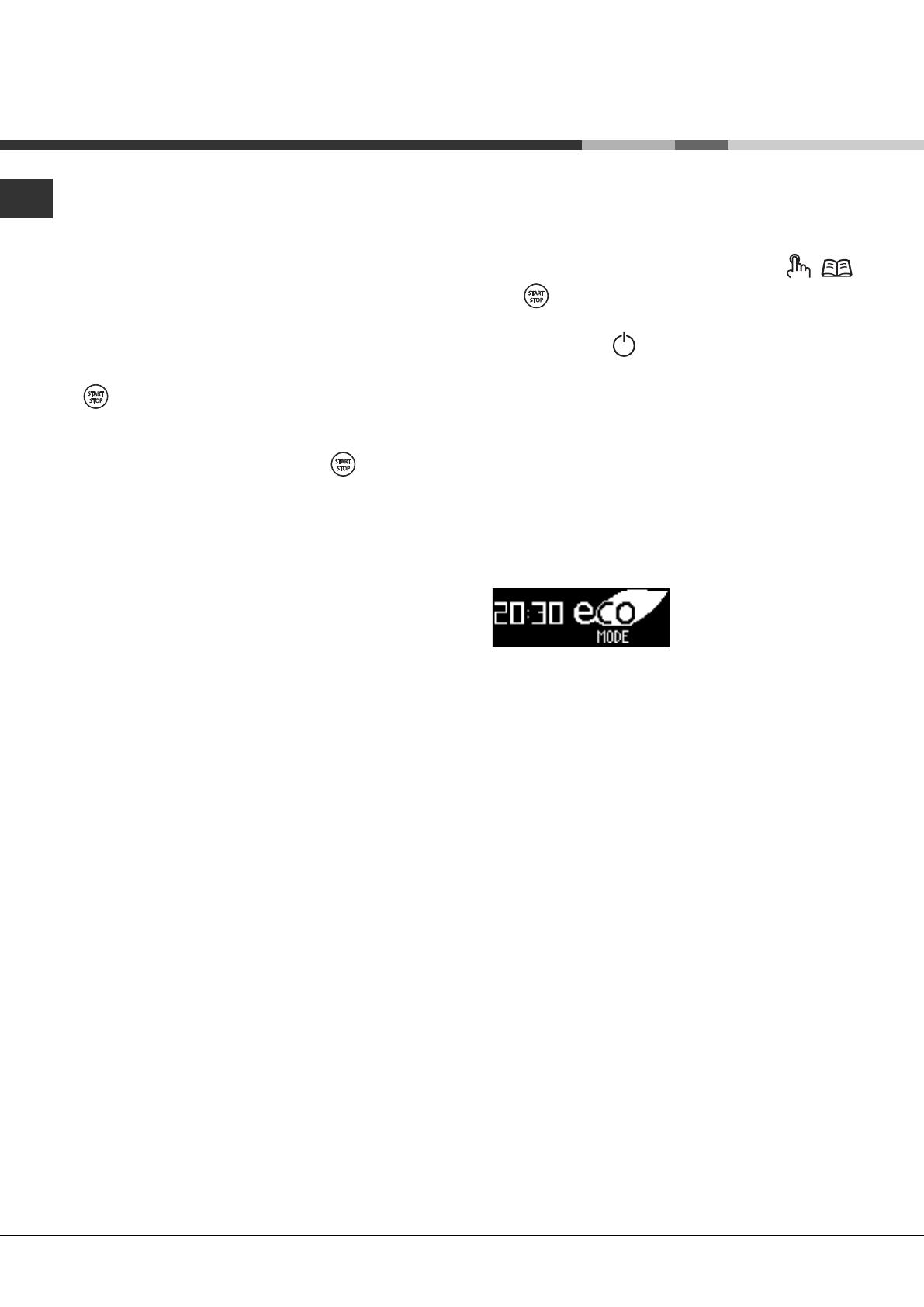
26
GB
inside the oven falls.
Demo mode
! The appliance will not enter DEMO mode if the
language has not been selected beforehand.
The oven can operate in DEMO mode: all heating
elements are deactivated, and the controls remain
operative.
To activate DEMO mode, switch off the oven and
keep the control dial turned clockwise while pressing
for 10 seconds. A buzzer sounds and the
display shows “DEMO”.
To deactivate DEMO mode, keep the control dial
turned anticlockwise while pressing
for 3
seconds. A buzzer sounds to confirm deactivation.
Restoring the factory settings
The oven factory settings can be restored to reset all
selections made by the user (language, tone,
customised durations, etc…). To carry out a reset,
switch off the oven, then press and hold 6
,
and simultaneously for 6 seconds. Once the
restore procedure is complete, a buzzer will sound.
The first time the
icon is pressed, the oven will
behave as if it is being switched on for the first time.
Standby
This product complies with the requirements of the
latest European Directive on the limitation of power
consumption in standby mode. If no buttons are
pressed for 30 minutes and the control panel/door
lock has not been activated, the appliance
automatically reverts to standby mode. The ECO
Mode symbol appears on the display to indicate
standby mode. As soon as interaction with the
machine resumes, system operation is restored.

GB
27
! In order to guarantee wonderfully soft and crunchy
foodstuffs, the oven releases – in the form of water
vapour - the humidity naturally withheld in the food
itself. In this way, optimal cooking results can be
achieved for all types of food.
! Every time the oven is switched on, it suggests the
first manual cooking mode.
Manual cooking modes
! All cooking modes have a default cooking temperature
which may be adjusted manually to a value between
40°C and 250°C as desired (270°C for GRILL mode).
Any temperature adjustments will be stored in the
appliance memory and suggested again the next time
this mode is used. If the selected temperature is lower
than the temperature inside the oven, the text “OVEN
TOO HOT” appears on the display. However, it will still
be possible to start cooking.
If cooking is started without a duration being set, the
display will show the elapsed time.
MULTILEVEL mode
All heating elements and the fan are activated. Since
the heat remains constant throughout the oven, the air
cooks and browns food in a uniform manner. A
maximum of three racks may be used at the same
time.
GRILL mode
The top heating element and the rotisserie spit
(where present) are activated. The high and direct
temperature of the grill is recommended for food
which requires a high surface temperature. Always
cook in this mode with the oven door closed (see
“Practical cooking advice”).
FAN GRILLING mode
The top heating element and the rotisserie spit (where
present) are activated and the fan begins to operate.
During part of the cycle the circular heating element is
also activated. This combination of features increases
the effectiveness of the unidirectional thermal
radiation provided by the heating elements through
the forced circulation of the air throughout the oven.
This helps prevent food from burning on the surface
and allows the heat to penetrate right into the food.
Always cook in this mode with the oven door closed
(see “Practical cooking advice”).
ROAST mode
The top and circular heating elements switch on and the
fan begins to operate. This combination of features
increases the effectiveness of the unidirectional thermal
radiation provided by the heating elements through the
forced circulation of the air throughout the oven. This
helps prevent food from burning on the surface and
allows the heat to penetrate right into the food.
Always cook in this mode with the oven door closed.
FISH mode
The top and circular heating elements switch on and
the fan begins to operate. This combination is ideal
for cooking fish dishes gently.
PIZZA mode
The top and circular heating elements switch on and
the fan begins to operate. This combination heats
the oven rapidly. If you use more than one rack at a
time, switch the position of the dishes halfway
through the cooking process.
PROVING mode
The circular heating element will come on and the
fan will operate during the preheating stage only.
The oven temperature is ideal for activating the
rising process. Always cook in this mode with the
oven door closed.
PASTRY mode
The rear heating element and the fan are switched
on, thus guaranteeing the distribution of heat in a
delicate and uniform manner throughout the entire
oven. This mode is ideal for baking temperature
sensitive foods (such as cakes, which need to rise).
PASTEURISATION mode
This cooking mode is suitable for fruit, vegetables, etc...
Small containers may be positioned on 2 levels
(dripping pan on the 1st shelf and rack on the 3rd
shelf). Let the containers cool inside the oven. Place
the food inside the oven while it is still cold.
SLOW COOK MEAT/FISH/VEGETABLES
modes
This type of cooking mode, used for years by industry
professionals, enables food (meat, fish, fruit and
vegetables) to be cooked at very low temperatures (75,
85 and 110°C), thereby guaranteeing a perfect level of
cooking and enhancing the taste as much as possible.
The value of these advantages should not be
underestimated:
• as the cooking temperatures are very low (in general
they are lower than the temperature required for
evaporation), the dispersion of cooking sauces due
to evaporation is substantially reduced and the food
Modes

28
GB
becomes softer;
• when cooking meat, the muscle fibres contract
less than they would during a classic cooking
cycle. The result is a more tender meat which
does not need to be rested after it is cooked.
Meat should be browned before it is placed in the
oven.
Cooking foods which have been vacuum-packed at
low temperatures, a technique used for over 30
years by the most prestigious chefs, brings many
advantages:
• culinary: flavours are concentrated and the taste,
softness and tenderness of the food are
maintained;
• hygienic: provided that hygiene regulations are
respected, this type of cooking protects the food
from the harmful effects of oxygen, thus ensuring
that the dishes may be stored for longer in the
refrigerator;
• organisational: thanks to the longer storage
period, dishes may be prepared well in advance;
• diet-related: this type of cooking limits the amount
of fatty substances used and therefore means
that the food is lighter and easier to digest;
• financial: the food shrinks less so there is more of
the product left after it has been cooked.
To use this technique, you must use a vacuum-
packing machine and the appropriate bags. Follow
the instructions supplied relating to vacuum-packing
food carefully.
The vacuum-packing technique may also be used
for raw products (fruit, vegetables, etc.) as well as
pre-cooked products (traditional cooking).
DEFROSTNG mode
The fan at the bottom of the oven circulates room-
temperature air around the food. This mode is suitable
for defrosting any type of food, especially delicate items
that should not be heated, for example: ice-cream
cakes or cakes made with custard, cream or fruit.
ECO mode
The rear heating element and the fan are switched on,
thus guaranteeing the distribution of heat in a delicate
and uniform manner throughout the entire oven.This
energy saving mode is recommended for small
dishes, ideal for heating foods and finishing off
cooking.
Rotisserie spit*
To operate the
rotisserie function (see
diagram) proceed as
follows:
1. Place the dripping
pan in position 1.
2. Place the rotisserie
support in position 3
and insert the spit in
the hole provided on
the back panel of the oven.
3. Start the rotisserie function by selecting the
or modes.
Automatic cooking modes
! The temperature and cooking duration are pre-
set , guaranteeing a perfect result every time -
automatically. These values are set using the
C.O.P.® (Programmed Optimal Cooking)
system. The cooking cycle stops automatically and
the oven indicates when the dish is cooked. You may
start cooking whether the oven has been preheated
or not. The cooking duration can be customised
according to personal taste by modifying the relevant
value - before cooking begins - by ±5/20 minutes
depending on the selected programme. The duration
can however be modified even once cooking has
begun. If the value is modified before the programme
begins, it is stored in the memory and suggested
again by the appliance when the programme is next
used. If the temperature inside the oven is higher than
the suggested value for the selected mode, the text
“OVEN TOO HOT” appears on the display and it will
not be possible to begin cooking; wait for the oven to
cool.
The icon representing the selected mode and the
icon representing the recommended shelf position
appear on the display alternately.
! When the cooking stage has been reached, the
oven buzzer sounds.
! Do not open the oven door as this will disrupt the
cooking time and temperature.
BREAD mode
Use this function to bake bread. To obtain the best
results, we recommend that you carefully observe
the instructions below:
• Follow the recipe.
• Do not exceed the maximum weight of the
* Only available in certain models.

GB
29
dripping pan.
• Remember to pour 50g (0,5 dl) of cold water
into the baking tray in position 5.
• The dough must be left to rise at room temperature
for 1 – 1 ½ hours (depending on the room
temperature) or until the dough has doubled in size.
Recipe for BREAD:
1 dripping pan holding 1000 g max, lower level
2 dripping pans each holding 1000 g max, medium
and lower levels
Recipe for 1000 g of dough: 600 g flour, 360 g water, 11g
salt, 25 g fresh yeast (or 2 sachets of powder yeast)
Method:
• Mix the flour and salt in a large bowl.
• Dilute the yeast in lukewarm water (approximately
35 degrees).
• Make a small well in the mound of flour.
• Pour in the water and yeast mixture.
• Knead the dough by stretching and folding it over
itself with the palm of your hand for 10 minutes until
it has a uniform consistency and is not too sticky.
• Form the dough into a ball shape, place it in a large
bowl and cover it with transparent plastic wrap to
prevent the surface of the dough from drying out.
Select the manual PROVING function on the oven.
Place the bowl inside and leave the dough to rise for
approximately 1 hour (the dough should double in
volume).
• Cut the dough into equal sized loaves.
• Place them in the dripping pan, on a sheet of
baking paper.
• Dust the loaves with flour.
• Make incisions on the loaves.
• Place the food inside the oven while it is still cold.
• Start the
BREAD cooking mode.
• Once baked, leave the loaves on one of the grill
racks until they have cooled completely.
BEEF/VEAL/LAMB mode
Use this function to cook beef, veal and lamb. Place the
food inside the oven while it is still cold. The dish may also
be placed in a preheated oven. Some of the ROAST modes
offer the option of selecting the desired cooking level:
1. Press the
icon.
2. Use the control dial to select “WELL DONE”,
“MEDIUM” or “RARE”.
3. Press
again.
PORK mode
Use this function to cook pork. Place the food inside
the oven while it is still cold. The dish may also be
placed in a preheated oven.
CHICKEN mode
This function is ideal for cooking chicken (whole or in
pieces). Place the food inside the oven while it is still
cold. The dish may also be placed in a preheated oven.
FISH FILLET mode
This function is ideal for cooking small-medium fillets.
Place the food inside the oven while it is still cold.
FISH EN PAPILLOTE mode
Use this function to cook whole fish with a maximum
weight of 1 kg. The paper/foil package can be
placed directly on the dripping pan. Place the food
inside the oven while it is still cold.
TARTS mode
This function is ideal for all tart recipes (which
normally need to be heated well from underneath).
Place the food inside the oven while it is still cold.
The dish may also be placed in a preheated oven.
SHORTCRUST TARTS mode
This function is ideal for all recipes which require
shortcrust pastry (usually made without eggs) or
have a liquid or very soft filling. Place the food
inside the oven while it is still cold. The dish may
also be placed in a preheated oven.
BRIOCHE mode
This function is ideal for baked desserts (made
using natural yeast). Place the food inside the oven
while it is still cold; the dish may also be placed in a
preheated oven if desired.
CAKE mode
This function is ideal for all recipes made using baking
powder. Place the food inside the oven while it is still
cold. The dish may also be placed in a preheated oven.
DESSERTS mode
This function is ideal for cooking desserts which are
made using natural yeast, baking powder and
desserts which contain no yeast. Place the dish in
the oven while it is still cold. The dish may also be
placed in a preheated oven.
PAELLA mode
This function was designed for quick and easy
paella preparation; all ingredients are placed inside
the oven while it is still cold. To obtain the best
results, we recommend that you carefully observe
the instructions below:
• The rice used must not be sticky: salad rice or
American long-grain rice are particularly suitable.
• The oven must not be preheated.

30
GB
• Position:
- the deep dripping pan on shelf level 1 (if
supplied as an accessory), or place the rack on
shelf level 1 and stand a dish measuring
approximately 35x30cm (height 5 cm) on it;
- the dripping pan on shelf level 3;
- the rack on shelf level 5;.
Recipe (serves 8):
In the deep dripping pan
• 1 onion, chopped
• 500 g rice
• 500 g frozen mixed seafood (shelled prawns,
mussels and clams, squid rings, etc.)
• 2 handfuls frozen peas
• ¼ chilli, diced
• Chorizo (spiced paprika sausage), sliced
• One tbsp fish stock powder
• 1 measure powdered saffron
• 700 g water
Cover the dripping pan with aluminium foil.
In the dripping pan
• 8 cod fillet portions
• 8 (or 16) king prawns (or scampi)
• 8 whole mussels, to garnish
Cover the dripping pan with aluminium foil.
On a tray standing on the rack
• 6-8 chicken thighs, marinated using paella spices
and a drizzle of olive oil
Once the cooking process is complete, finish with
more olive oil.
PILAU RICE mode
Use this function to cook rice. To obtain the best
results, we recommend that you observe the
instructions below:
• The rice used must not be sticky: salad rice or
American long-grain rice are particularly suitable.
• The oven must not be preheated.
• The deep dripping pan should be on shelf level 2
(if supplied as an accessory), or the rack placed
on shelf level 2 and a dish measuring
approximately 35x30cm (height 5 cm) stood on it.
Recipe (serves 4 - 6):
• 500 g rice
• 700 ml water or stock
Place the rice in the deep dripping pan without
soaking and cover with liquid. Cover the dripping
pan with the aluminium foil.
YOGHURT mode
The circular heating element will come on and the fan
will operate during the preheating stage only. The
temperature of 50°C is ideal for preparing yoghurt.
Basic recipe for one litre of yoghurt: one litre of
whole UHT milk, one pot of natural yoghurt
Method:
• Heat the milk in a steel pan until it reaches boiling
point.
• Remove the layer of cream on the surface and
leave to cool.
• Stir 3 or 4 tablespoons of milk into the yoghurt
and combine well.
• Add the mixture to the remaining milk and mix
thoroughly.
• Pour into airtight jars.
• Stand the jars on the dripping pan and place in
the oven, on level 2.
• At the end of this process, place the jars in the
refrigerator to chill for at least 12 hours. Store the
yoghurt in the refrigerator for up to one week.
• The recipe can be adjusted to taste.
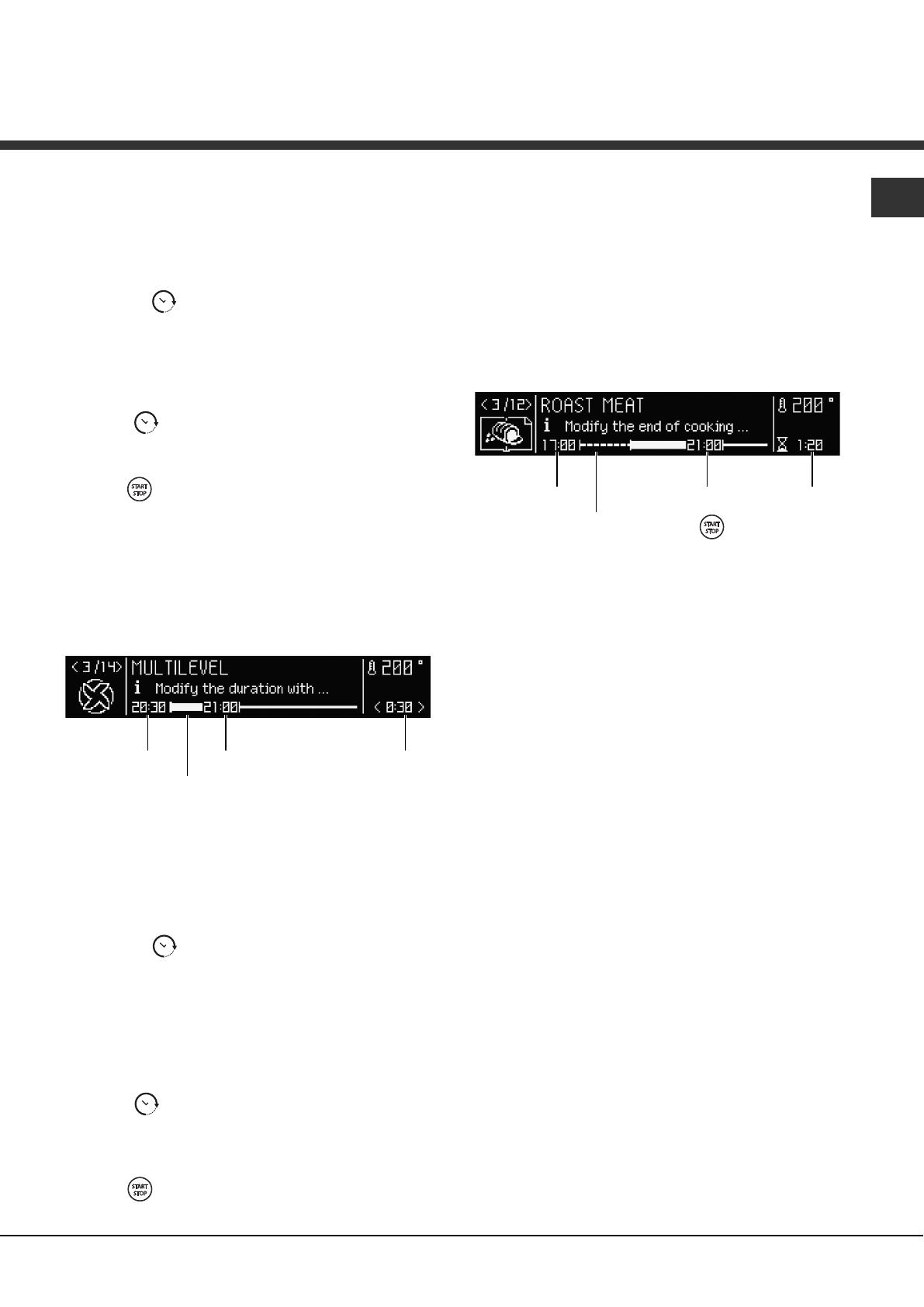
GB
31
Programming cooking
! A cooking mode must be selected before
programming can take place.
Programming the duration
1. Press the
icon.
2. Turn the control dial to set the duration; hold the dial in
this position to scroll through the numbers more quickly
and make the setting process easier. The display will
show a graphic indicating the duration in bar format.
3. Once you have reached the desired duration,
press the
icon again. The duration bar will show
the current time, the duration and the end of cooking
time as a graphic.
4. Press
to begin cooking.
5. The display will indicate the remaining time by
filling the duration bar.
6. When cooking has finished, “COOKING FINISHED”
appears on the display and a buzzer sounds.
• For example: it is 9:00 a.m. and a duration of 1
hour and 15 minutes is programmed. The
programme will stop automatically at 10:15 a.m.
Programming delayed cooking
! A cooking duration must be set before the end of
cooking time can be scheduled.
! For the delayed programming to work properly, the
clock should be set to the correct time.
1. Follow steps 1 to 3 to set the duration as detailed
above.
2. Press the
icon twice; the end of cooking time
will begin to flash.
3. Turn the control dial to adjust the end of cooking
time; hold the dial in this position to scroll through
the numbers more quickly and make the setting
process easier. The display will show a graphic
indicating the delayed start in bar format.
4. Once you have reached the desired end time,
press the
icon again. The delayed start bar will
show the current time, the time remaining until the
start of cooking, the duration and the end of cooking
time as a graphic.
4. Press
to begin the pyrolysis schedule.
5. The text “POSTPONED COOKING START” and the
time remaining will appear on the display, moving
the delayed start bar backwards.
6. Once cooking has begun, the display will indicate
the remaining time by filling the duration bar.
7. When the time has elapsed, “COOKING FINISHED”
appears on the display and a buzzer sounds.
• For example: it is 9:00 a.m. and a time of 1 hour
and 15 minutes is programmed, while the end
time is set to 12:30. The programme will start
automatically at 11:15 a.m.
To cancel a schedule, press the
icon.
Practical cooking advice
! Do not place racks in position 1 and 5 during fan-
assisted cooking. This is because excessive direct
heat can burn temperature sensitive foods.
! In the GRILL and FAN GRILLING cooking modes,
particularly when using the rotisserie spit, place the
dripping pan in position 1 to collect cooking
residues (fat and/or grease).
MULTILEVEL
• Use positions 2 and 4, placing the food which
requires more heat on 2.
• Place the dripping pan on the bottom and the rack
on top.
GRILL
• Place the rack in position 3 or 4. Position the food
in the centre of the rack.
• We recommend that the temperature is set to its
maximum level. The top heating element is
regulated by a thermostat and may not always
operate constantly.
PIZZA
• Use a lightweight aluminium pizza pan. Place it on
the rack provided.
For a crispy crust, do not use the dripping pan as
this extends the total cooking duration and
prevents the crust from forming.
• If the pizza has a lot of toppings, we recommend
adding the mozzarella cheese to the top of the
pizza halfway through the cooking process.
Current time
indicator
End of cooking
time
Delayed
start bar
Cooking
duration
Current time
indicator
End
of cooking time
Duration
bar
Cooking
duration

32
GB
Cooking advice table
Modes Foods Weight
(in kg)
Rack position Preheating Recommended
Temperature
(°C)
Cooking
duration
(minutes)
Manual
Standard
guide rails
Sliding
guide rails
Multilevel*
Pizza on 2 racks
Pies on two racks/cakes on 2 racks
Sponge cake on 2 racks (on the dripping pan)
Roast chicken + potatoes
Lamb
Mackerel
Lasagne
Cream puffs on 3 racks
Biscuits on 3 racks
Cheese puffs on 2 racks
Savoury pies
1+1
1
1
1
2 and 4
2 and 4
2 and 4
1 and 2/3
2
1 or 2
2
1 and 3 and 5
1 and 3 and 5
2 and 4
1 and 3
1 and 3
1 and 3
1 and 3
1 and 3
1
1
1
1 and 2 and 4
1 and 2 and 4
1 and 3
1 and 3
yes
yes
yes
yes
yes
yes
yes
yes
yes
yes
yes
20-25
30-35
20-25
65-75
45-50
30-35
35-40
20-25
10-20
20-25
20-30
Grill*
Mackerel
Sole and cuttlefish
Squid and prawn kebabs
Cod fillet
Grilled vegetables
Veal steak
Sausages
Hamburgers
Toasted sandwiches (or toast)
Spit-roast chicken using rotisserie spit (where present)
Spit-roast lamb using rotisserie spit (where present)
1
0,7
0,7
0,7
0,5
0,8
0,7
n° 4 or 5
n° 4 or 6
1
1
4
4
4
4
3 or 4
4
4
4
4
-
-
3
3
3
3
2 or 3
3
3
3
3
-
-
no
no
no
no
no
no
no
no
no
no
no
300
300
300
300
300
300
300
300
300
300
300
10-20
10-15
10-15
10-15
15-20
10-20
10-20
10-12
3-5
70-80
70-80
Fan grilling*
Grilled chicken
Cuttlefish
Spit-roast chicken using rotisserie spit (where present)
Spit-roast duck using rotisserie spit (where present)
Roast veal or beef
Roast pork
Lamb
1,5
1
1,5
1,5
1
1
1
2
2
-
-
2
2
2
2
2
-
-
2
2
2
no
no
no
no
no
no
no
210
200
210
210
210
210
210
55-60
30-35
70-80
60-70
60-75
70-80
40-45
Roast*
Roasts (white or red meat) 1 2 2 no 200 50-75
Fish*
Bream
Fish fillets
Sea bass with potatoes
0,7
1
0,5 + 0,5
2
2
2
2
2
2
yes
yes
yes
180
170
190
20-25
12-15
60
Pizza*
Pizza
Focaccia bread
0,5
0,5
2
2
1
1
yes
yes
15-20
20-25
Proving*
Rising process for dough made with yeast
(brioches, bread, sugar pie, croissants, etc.).
2 2 no 40
Pasteurisation*
Fruit, vegetables, etc. 2 2 yes 110
Slow cook*
Meat
Fish
Vegetables
2
2
2
1
1
1
no
no
no
75
85
110
90-180
90-180
90-180
Defrosting*
* The cooking times listed above are intended as guidelines only and may be modified according to personal tastes. Oven preheating times are set as
standard and may not be modified manually.
! ECO programme: This programme – which has longer cooking times but guarantees sensible energy saving – is recommended for dishes such as fish fillets,
small pastries and ve
g
etables. It is also suitable for warmin
g
foodstuffs and for completin
g
cookin
g
.
All frozen foods
210-220
180
160-170
200-210
190-200
180
180-190
190
180
210
190-200
210-220
190-200
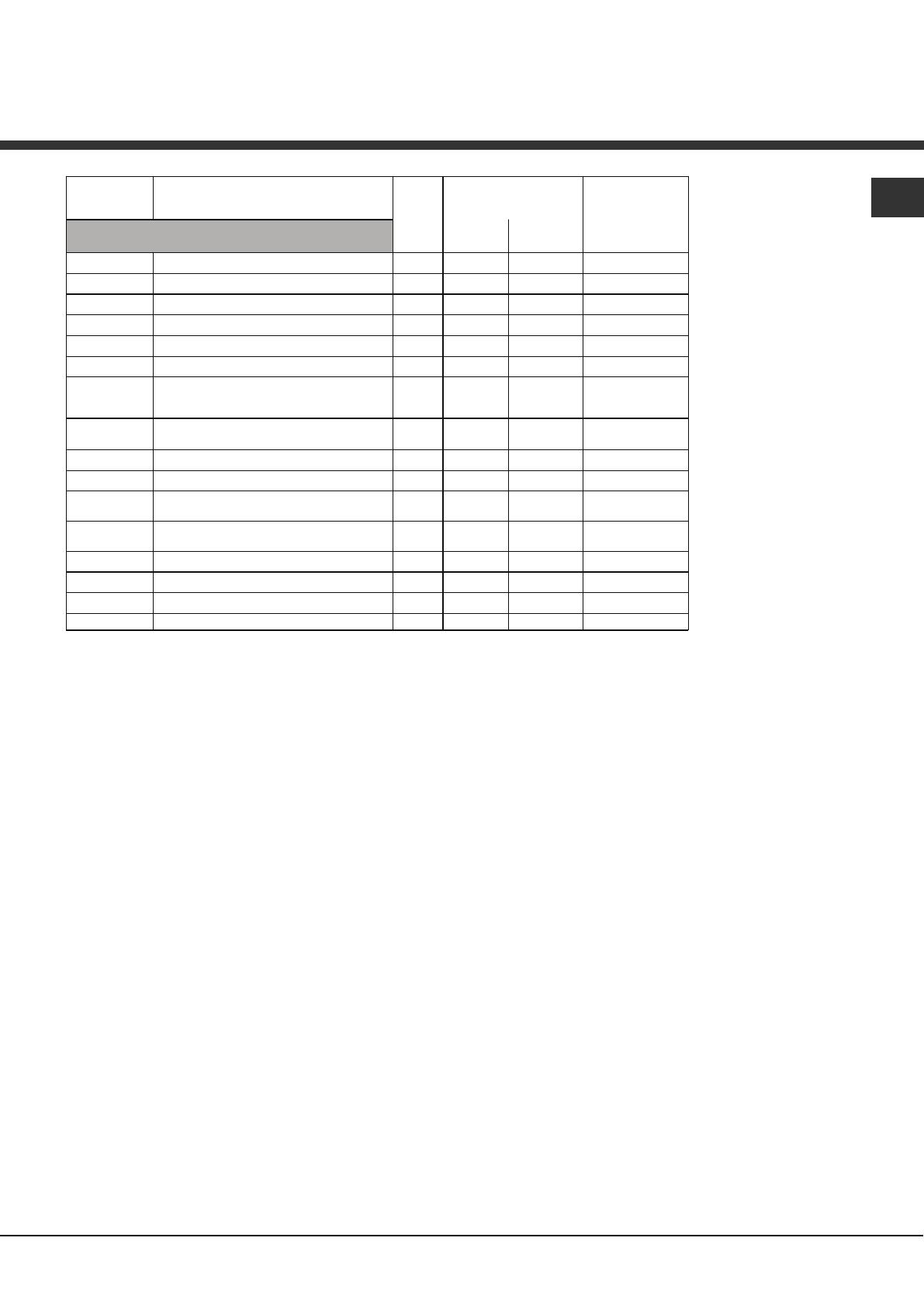
GB
33
Modes Foods Weight
(in kg)
Rack position Preheating
Automatic*
Standard
guide rails
Sliding
guide rails
Bread**
Bread (see recipe)
1 2 or 3 2 no
Beef
Roast beef
2 or 3 2 no
Veal
Roast veal
2 or 3 2 no
Lamb
Leg of lamb
2 or 3 2 no
Pork
Roast pork
2 or 3 2 no
Chicken
Roast chicken
1-1,5 2 or 3 2 no
Fish fillet
Cod
Perch
Trout
0,4-0,5
0,4-0,5
0,4-0,5
2 or 3
2 or 3
2 or 3
2
2
2
no
no
no
Fish en
papillote
Bream
Sea bass
0,4-0,5
0,4-0,5
2 or 3
2 or 3
2
2
no
no
Tarts
Tarts
0,5 2 or 3 2 no
Shortcrust tarts
Apple flan
0,5 2 or 3 2 no
Brioche
Desserts made with natural yeast (brioches, almond
cake, etc.)
0,7 2 or 3 2 no
Cake
Desserts made with baking powder
(marbled biscuits, pound cake, etc.)
0,7 2 or 3 2 no
Desserts
Desserts
1 2 or 3 2 no
Paella
Paella (see recipe)
1-3-5 1-2-4 no
Pilau rice
Pilau rice (see recipe)
0,5 2 1 no
* The duration of the automatic cooking functions are set by default. The values can be modified by the user, starting with the default duration.
** As stated in the recipe, pour 50 g (0,5 dl) water into the dripping pan in position 5.
Yoghurt
Yoghurt 2 2 yes
1-1,5
1-1,5
1-1,5
1,2-1,5

34
GB
Precautions and tips
! This appliance has been designed and
manufactured in compliance with international safety
standards. The following warnings are provided for
safety reasons and must be read carefully.
General safety
• The appliance was designed for domestic use
inside the home and is not intended for
commercial or industrial use.
• The appliance must not be installed outdoors, even
in covered areas. It is extremely dangerous to
leave the appliance exposed to rain and storms.
• When moving or positioning the appliance, always
use the handles provided on the sides of the oven.
• Do not touch the appliance while barefoot or with
wet or damp hands and feet.
• The appliance must be used by adults only
for the preparation of food, in accordance
with the instructions provided in this
booklet. Any other use of the appliance (e.g.
for heating the room) constitutes improper
use and is dangerous. The manufacturer
may not be held responsible for any damage
caused as a result of improper, incorrect
and unreasonable use of the appliance.
• Do not touch the heating elements or certain
parts of the oven door when the appliance is
in use; these parts become extremely hot.
Keep children well away from the appliance.
• Make sure that the power supply cables of other
electrical appliances do not come into contact
with the hot parts of the oven.
• The ventilation and heat dispersal openings must
never be obstructed.
• Always grip the oven door handle in the centre:
the ends may be hot.
• Always use oven gloves when placing cookware
in the oven or when removing it.
• Do not use aluminium foil to line the bottom of the
oven.
• Do not place flammable materials in the oven: if
the appliance is switched on accidentally, the
materials could catch fire.
• When unplugging the appliance, always pull the plug
from the mains socket; do not pull on the cable.
• Do not perform any cleaning or maintenance work
without having disconnected the appliance from
the electricity mains.
• If the event of malfunctions, under no circumstances
should you attempt to perform the repairs yourself.
Contact an authorised Service Centre (see
Assistance).
• Do not rest objects on the open oven door.
• Do not let children play with the appliance.
• The appliance should not be operated by people
(including children) with reduced physical,
sensory or mental capacities, by inexperienced
individuals or by anyone who is not familiar with
the product. These individuals should, at the very
least, be supervised by someone who assumes
responsibility for their safety or receive
preliminary instructions relating to the operation of
the appliance.
Disposal
• When disposing of packaging material: observe
local legislation so that the packaging may be
reused.
• The European Directive 2002/96/EC relating to
Waste Electrical and Electronic Equipment
(WEEE) states that household appliances should
not be disposed of using the normal solid urban
waste cycle. Exhausted appliances should be
collected separately in order to optimise the cost
of re-using and recycling the materials inside the
machine, while preventing potential damage to
the atmosphere and to public health. The
crossed-out dustbin is marked on all products to
remind the owner of their obligations regarding
separated waste collection.
For further information relating to the correct
disposal of exhausted household appliances,
owners may contact the relevant public service or
their local dealer.
Respecting and conserving the
environment
• You can help to reduce the peak load of the
electricity supply network companies by using the
oven in the hours between late afternoon and the
early hours of the morning. The cooking mode
programming options, the “delayed cooking”
mode (see Cooking modes) and “delayed
automatic cleaning” mode (see Care and
Maintenance) in particular, enable the user to
organise their time efficiently.
• Always keep the oven door closed when using the
GRILL and FAN GRILLING modes: this will
achieve improved results while saving energy
(approximately 10%).
• Check the door seals regularly and wipe them
clean to ensure they are free of debris so that
they adhere properly to the door, thus avoiding
the dispersal of heat.
! This product complies with the requirements of the
latest European Directive on the limitation of power
consumption in standby mode.
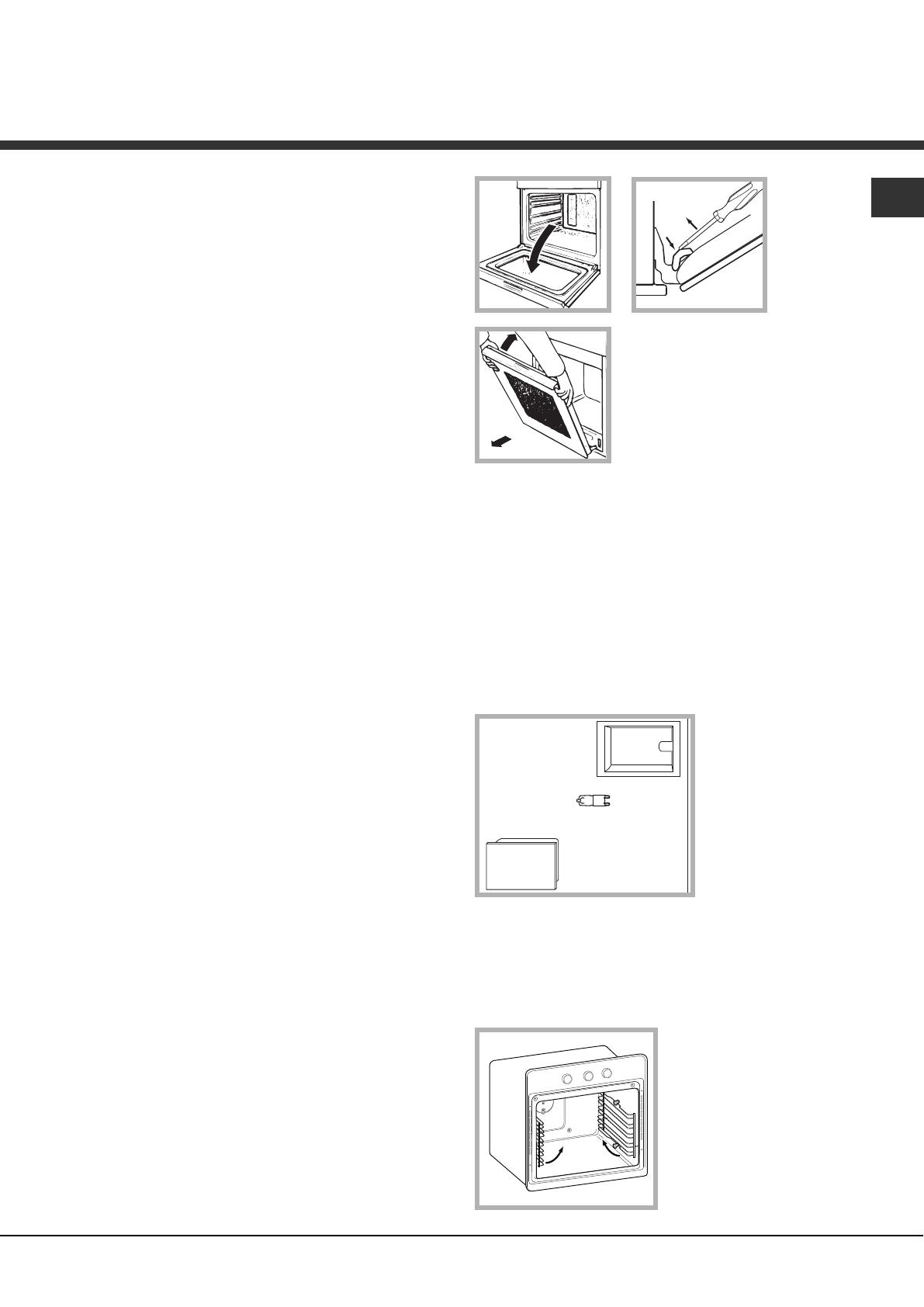
GB
35
Switching the appliance off
Disconnect your appliance from the electricity
supply before carrying out any work on it.
Cleaning the appliance
• Slight differences in colour on the front of the oven
are due to the different materials used, i.e. glass,
plastic or metal.
• Any shady areas resembling grooves on the oven
door glass are caused by reflections from the
oven light.
• The enamel is branded at very high temperatures.
This process may cause colour variations. This is
normal and will not affect appliance operation in
any way. The thin edges of the sheet metal
cannot be entirely enamelled and may therefore
appear to be unfinished. This will not affect the
rust protection.
• The stainless steel or enamel-coated external
parts and the rubber seals may be cleaned using
a sponge that has been soaked in lukewarm water
and neutral soap. Use specialised products for
the removal of stubborn stains. After cleaning,
rinse and dry thoroughly. Do not use abrasive
powders or corrosive substances.
• The inside of the oven should ideally be cleaned
after each use, while it is still lukewarm. Use hot
water and detergent, then rinse well and dry with
a soft cloth. Do not use abrasive products.
• All accessories - with the exception of the sliding
racks - can be washed like everyday crockery,
and are even dishwasher safe.
• We recommend that detergents are not sprayed
directly onto the control panel, but that a sponge
is used instead.
! Never use steam cleaners or pressure cleaners on
the appliance.
Cleaning the oven door
! The door of LED INSIDE models cannot be
removed.
Clean the glass part of the oven door using a
sponge and a non-abrasive cleaning product, then
dry thoroughly with a soft cloth. Do not use rough
abrasive material or sharp metal scrapers as these
could scratch the surface and cause the glass to
crack.
For more thorough cleaning purposes, the oven door
may be removed:
1. Open the oven door fully (see diagram).
2. Use a screwdriver to lift up and turn the small
levers F located on the two hinges (see diagram).
3. Grip the door on the two
outer sides and close it
approximately half way. Pull
the door towards you, lifting it
out of its slot (see diagram).
To replace the door, reverse
this sequence.
Inspecting the seals
Check the door seals around the oven regularly. If
the seals are damaged, please contact your nearest
Service Centre (see Assistance). We recommend
that the oven is not used until the seals have been
replaced.
Replacing the light bulb
To replace the oven light bulb:
1. Remove the glass cover of the lamp-holder.
2. Remove the
light bulb and
replace it with a
similar one:
halogen lamp
voltage 230 V,
wattage 25 W,
cap G 9.
3. Replace the
glass cover (see
diagram).
! Do not touch the light bulb directly with your
hands.
Sliding rack kit assembly
To assemble the
sliding racks:
1. Remove the two
frames, lifting them
away from the spacers
A (see figure).
Care and maintenance
Glass cover
Lamp
Lamp Holder
compartment
F
A
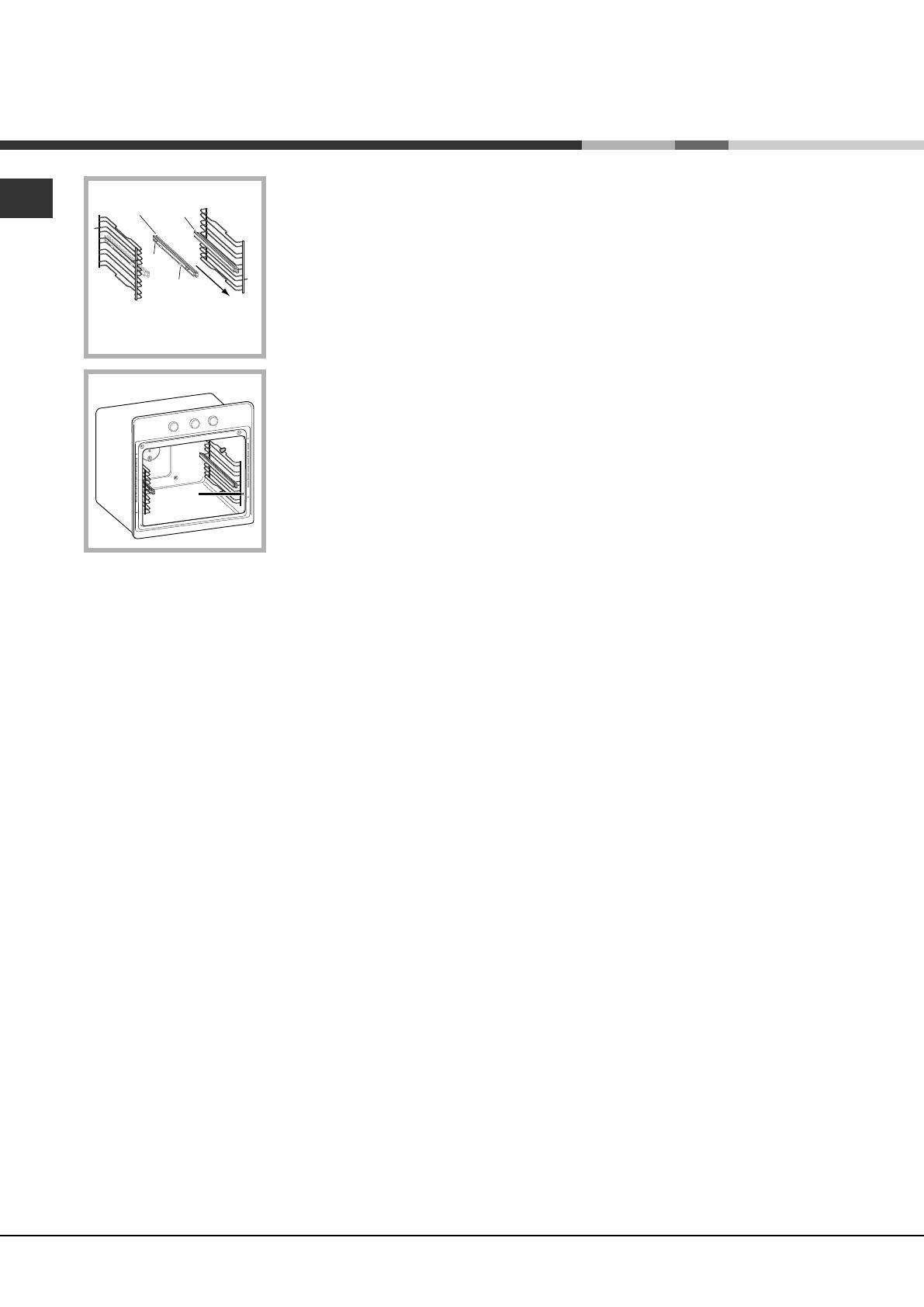
36
GB
2. Choose which shelf
to use with the sliding
rack. Paying attention
to the direction in which
the sliding rack is to be
extracted, position joint
B and then joint C on
the frame.
3. Secure the two frames
with the guide rails using
the holes provided on
the oven walls (see
diagram). The holes for
the left frame are
situated at the top, while
the holes for the right
frame are at the bottom.
4. Finally, fit the frames
on the spacers A.
! Do not place the sliding racks in position 5.
Side and rear catalytic liners*
These are panels coated with a special enamel,
which is able to absorb the fat released by food as it
cooks.
This enamel is quite strong, so that the various
accessories (racks, dripping pans, etc.) can slide
along them without damaging them. White marks
may appear on the surfaces; these are not a cause
for concern.
Nevertheless, the following should be avoided:
- scraping the enamel with sharp objects (a knife, for
example);
- using detergents or abrasive materials.
D
B
C
Left
guide rail
Right guide
rail
Direction
of extraction
*
Only available in certain models.

GB
37
Troubleshooting
Problem Possible cause Solution
A programmed cooking mode
does not start.
There has been a blackout. Reprogram the cooking mode.
The display shows ECO Mode.
The appliance is in standby
mode.
Press any button to exit standby
mode.
An automatic mode has been
selected. “Hot” appears on the
dis
p
la
y
and cookin
g
does not start.
The temperature inside the oven
is higher than the suggested
value for the selected mode.
Wait for the oven to cool down.
Fan-assisted cooking has been
selected and the food looks
burnt.
Positions 1 and 5: the direct
heat could cause
temperature-sensitive
foods to burn.
We recommend switching
dripping pan positions halfway
through cooking.

38
GB
Warning:
The appliance is fitted with an automatic diagnostic system which detects any malfunctions. Malfunctions are
signalled through messages of the following type: “F—” followed by numbers.
Call for technical assistance in the event of a malfunction.
Before calling for Assistance:
• Check whether you can fix the problem yourself.
• Restart the programme to check whether the malfunction has disappeared.
• If it has not, contact the Authorised Technical Assistance Service.
! Never use the services of an unauthorised technician.
Please have the following information to hand:
• The type of problem encountered.
• The message displayed.
• The appliance model (Mod.).
• The serial number (S/N).
The latter two pieces of information can be found on the data plate located on the appliance.
Assistance
/